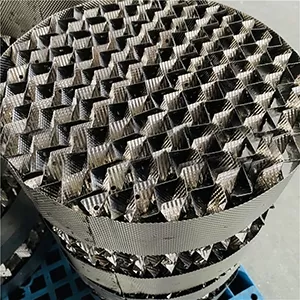How to Calculate the Specific Surface Area of structured packing?
The specific surface area of structured packing—defined as the total surface area available for gas-liquid contact per unit volume of the packing—is a key parameter that directly influences mass transfer efficiency. Calculating this value involves both geometric analysis of the packing’s structure and, in some cases, experimental validation to account for real-world factors. Here are the primary methods and considerations:

Geometric Calculation Method
For most structured packing, especially corrugated sheet or mesh types, the specific surface area can be estimated through geometric analysis of its repeating unit structure. This method relies on the packing’s design parameters, which are typically provided by manufacturers. The steps are as follows:
- Identify the repeating unit: Structured packing is composed of uniform, repeating modules (e.g., corrugated sheets with a fixed pitch and height). Focus on a single unit or section that represents the entire packing structure.
- Calculate surface area of the unit: For corrugated sheet packing, measure the dimensions of one corrugated sheet segment, including its length, width, and corrugation depth. The total surface area of the sheet (including both sides) is calculated, accounting for the increased area due to corrugation. For mesh packing, the surface area is derived from the total length and diameter of the mesh filaments within the unit.
- Determine the volume of the unit: Measure the volume occupied by the repeating unit, considering its height, width, and depth in the packed bed.
- Compute specific surface area: Divide the total surface area of the repeating unit by its volume. This gives the theoretical specific surface area, often expressed in square meters per cubic meter (m²/m³).
Manufacturers typically provide this theoretical specific surface area as a standard specification (e.g., 250 m²/m³, 500 m²/m³ for common corrugated packing). However, this value represents an idealized geometric calculation and may not account for factors like overlapping sheets or surface irregularities.
Experimental Measurement: Gas Adsorption Method
To validate or refine the geometric calculation, experimental methods such as gas adsorption (e.g., BET method) are used. This technique measures the actual surface area accessible to a adsorbate gas, providing a more accurate value that includes microscale features like surface roughness or porosity:
- Sample preparation: A small sample of the structured packing is cleaned to remove contaminants, ensuring the surface is free of oils or residues that could interfere with adsorption.
- Gas adsorption analysis: The sample is placed in a BET analyzer, where it is exposed to a gas (typically nitrogen) at low temperatures. The gas adsorbs onto the packing’s surface, and the amount of adsorbed gas is measured.
- Calculate surface area: Using the BET theory, which describes the multilayer adsorption of gas molecules on a solid surface, the total surface area of the sample is computed. Dividing this by the sample’s volume gives the specific surface area.
This method is particularly useful for porous or textured structured packing (e.g., ceramic mesh packing) where geometric calculations may underestimate the actual surface area due to microscale porosity.
Considerations for Accuracy
- Manufacturer specifications: Most reputable manufacturers provide the specific surface area as part of their product data, based on rigorous geometric and experimental testing. This is often the most reliable reference for industrial applications.
- Effect of installation: In practice, the specific surface area can be slightly reduced by factors like gaps between packing layers or compression during installation. However, these effects are usually minimal and not included in standard calculations.
- Material thickness: For sheet-based packing, the thickness of the material itself does not contribute to the active surface area for mass transfer, so it is excluded from surface area calculations. Only the exposed surfaces in contact with gas or liquid are counted.
Example for Corrugated Packing
For a typical corrugated sheet packing with a corrugation pitch (distance between adjacent corrugation peaks) of 10 mm and a corrugation height of 5 mm, the surface area per unit volume can be approximated. If each sheet in a 1 m³ volume has a total exposed surface area of 500 m² (after accounting for corrugation), the specific surface area is 500 m²/m³—a common specification for high-efficiency structured packing.
In summary, the specific surface area of structured packing is primarily calculated through geometric analysis of its repeating structure, with experimental methods like BET adsorption used for validation. Manufacturer-provided values, derived from these methods, are the standard reference for industrial design and performance evaluation.

